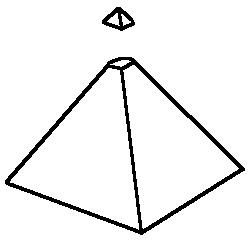
Bernard I. Pietsch
Excerpt from work in progress
Introduction to the Canon of Measure
One would think that the paradigm of mathematics cannot be questioned,
since the laws of mathematics are already surely known. This report
deals with elements of a paradigm not found in contemporary mathematics
nor in anthropology nor in art history. It begs the question: "Is
there a paradigm in Art which transcends the classical categories of
line, form, composition and spatial arrangement? Is it possible that
some level of communication exists which has eluded the reconstructions
of contemporary archeology?" The answer to these questions lies in
the recovery of an ancient wisdomatic we refer to as the
Essential Canon of Measure.
Following a brief introduction to the Essential Canon of Measure and how it applies to ancient art and metrology, the science of measurement, we will take a closer look at a Chinese art work rendered in jade about 3,000 years ago. The metrological elements of the Stone of Heaven illustrate a synthesis of art, form and science not expressed in modern thinking. We will suggest that ancient monumental works affirm in their metrological levels, individual attainment of high intuition and natural understanding. We will also contend that a return to an ancient paradigm of value is within our grasp. Monumental works perceived through the lens of the Essential Canon of Measure will be the vehicle of this exploration.
Physiology Organizes Metrology
The jade disc to which we will refer, actualizes a universal system of
measure we designate as the Essential Canon of Measure.
It is an essential system abstracted by the mind from the
Natural Order and derived from eons of evolution of biological rhythms,
astrophysical cycles and planetary harmonics. Heartbeat, breath and
other cycles of the body are the result of the participation of our
earth bound life form in the universal process of evolution. These
human physiological frequencies reside at the core of the
Canon. The Canon is not invented. It
is derived. It is a system that emerges into consciousness and
is perceived at the level of the individual's awareness, i.e., awareness
of the Self precedes access to the Canon.
As idealized numbers, Canon measures represent dynamic processes which in the real world are variable. Periodicities of the planets, tidal cycles and beats of the heart fluctuate. Canon Measures are perfect abstractions—they do not exist, yet we recognize the patterns that they indicate. For example 60 heartbeats for 60 seconds of time or the number 360 as both degrees in the circle as well as the number of days in the sacred year of the ancients.
The Canon is Perennial, not Conventional
Historically, units of measure differ from one culture to
another—conventional manifestations of a Chinese, Egyptian or Mayan
"inch" for example, are all different. Generally, these measures
are believed to be related to some aspect of anatomy such as
length of forearm, foot, knuckle, or other contrived standard.
Canon measures are are categorically different; they are derived
from human physiology, they transcend all culture, yet inform it.
Because the cycles of the body are the universal organizer of all systems, sychronistically each system is convertible into the others. Monumental Art therefore, regardless of its country of origin or epoch, is the expression of a Perennial Domain of Harmony, perceived and rendered into form by the understanding of the artificer. The talent of the artist lies in his or her ability to conceive through ratios, proportions, line and measure, an art form which reveals in its structure, an understanding of universal processes.
Art, Geometry and Measure Precede Semantics
One in possession of the Canon, and who understands the
process, can "read" a monument as it was intended to be seen
by its maker, in any century or civilization. Because the process
functions the way the mind and body work, the system can surface
anywhere in the world. To use an alchemical term, the
Canon, is a universal solvent, or solution; it is to
metrology what the archetype is to mythology— or the image is to a
hologram. As with the hologram, the Canon has no
existence per se; it is the individual's perception that gives it
intelligible form. Prior to language, prior to culture, the
Canon emerges—through the Art we intuitively
revere as Monumental or indicative of the Sacred.
Monumental Art Indicates the Sacred
The sacred does not exist; but it can be experienced. There are
many sublime examples of metaphysical art in the monument world, but an
architectural metaphor can merely "point" to the sacred. It is
only through the participation of the witness/observer that
sacred or unseen levels can be accessed. Through participation with the
art form, a moment of openness may transpire and a new way of
seeing may be experienced. Transformation may occur. It is the act
of transformation which renders the instant sacred.
In a universe wherein all is becoming, changing, evolving, it is unthinkable that anything or process is final. Hence in many of the great monuments and art forms of the world, we find an element of the unfinished, missing or incomplete. This open-ended aspect of Monumental Art is a hallmark of the ancient builders. The act of completion and the opportunity to savor the experience of discovering the sacred for him or herself is reserved for the participant/observer.

The space above the 206th course is so
geometrically perfect that it cannot have existence—but it can be
conceptualized. The information in the top is of a different order than that
conveyed in the physical pyramid, but it is derivable. Herodotus said,
"The pyramid was built from the top down." Herodotus meant not
that it was constructed from the top down, but that it was
conceived from the top down. The 206 courses of the pyramid
exist, in stone as a physical record of tidal and planetary
history during a corresponding period of 206 years. The pyramidian on
the other hand is not. It can only be conceptualized. It is an
ideal form, but a necessary adjunct to the ordering of the physical
pyramid. It is the potential of the invisible top that inaugurates the
physical pyramid. The idea drives the form.
Monumental Art Invokes Synchronicity
There are no "secrets" and no "sacred" in Art.
Secrets and the sacred reside in the observer, not in the observed.
Liberating the secret/sacred requires movement on the part of the
observer—movement from one category of observation to a higher. Sacred
Art constantly reminds us: There are many levels. Do not be attached to
one viewpoint.
Monumental Art is also characterized by the interrelatedness of the individual components of its form. By design the parts not only work together, but incorporate a high degree of commensurability between divergent categories. For example, inches may be read as units of time, angles may be seen as lengths, linear measures as weights, weights as volume. The term synchronicity is often applied to such coincidences; but when diverse individual events are seen as part of a larger framework, synchronicity gives way to understanding that coincidence is co (inside) dence.
In the grandest sense of sychronicity, the Canon value of the Golden Number Ratio 1.618122977 is at the core of all natural and dynamic processes in nature. Every organism, every drop of water, every twist of plant growth or movement of the planets conforms in its way to the law of the Golden Mean. Its dominion is omnipresent. The simplest organism demonstrates in each moment of its growth and being, its individual response to the contribution of the total universe. The organism participates with the universe and structures its response into form. The structure of the form is the history of that response.
The Canon is the Perrenial Interface Between Art and Science
The Canon represents the harmonization of inner and outer worlds,
above and below. Because the Canon is the repository of
frequencies as number, a single number can refer to different
scales or degrees. Like the moment, the concept of place
can be as immense as the galaxy and as immediate as the center of the
Self; each is singular but on a vastly different scale. The Great
Pyramid, for example represents simultaneously one second of time and
one rotation of the galaxy. Its form expresses both one heartbeat and
many millennia. The mystery is that both exterior/interior, past/future
can be harmonized by the realization that circumference and center are
one. Here/Now is precisely that. When one is in submission, in
no-time, in no-thought, the integrity of the moment may be allowed to
surface. Transformation, the deepest reconciliation of the self, can be
experienced.
An ancient work like an obelisk, stone circle, dolman, standing stone or temple may refer by measure or geometry to its Time/Location. Because Time is an essential feature of the Canon, there may be no apparent reference to Time in a work itself. If the observer/participant is willing to engage in new ways of observing, unexpected levels of information may be yielded by the work. By applying some form of timing device: calibrated drops of water, celestial observation, falling weights,etc. We can decode information about Time and timing not otherwise available.
For example, the essence of Time/Place in an art form may be divined by invoking the laws of the precessing pendulum (Foucault formula). The precessing pendulum can be used to determine geographic location in latitude above or below the geographic equator. By invoking the laws of the pendulum, any feature of a work, whether it be the height of a doorway, area of a wall or length of a perimeter edge can be transformed into a period of time.
One famous site that demonstrates the knowledge of Time/Place is the Inti-Huatana (Hitching Post of the Sun) at the top of the pyramid at Macchu Picchu, Peru. The sculptured form is a truncated, four sided pyramid. The design is such that the angle of inclination of the top plane, with respect to level is coincident with the value of the latitude of Macchu Picchu south of the Equator: -13.1415.
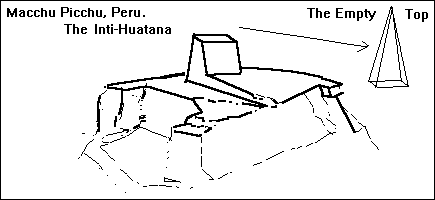
When the vertice corners of the Inti-Huatana pyramid are extended upward, an inferential pyramidian is created. The height of its indicated apex is 72.5" above the middle of the existing top plane. Sychronistically, 72.5 also represents the degrees of longitude of Macchu Picchu west of the Prime Meridian.
Stone of Heaven
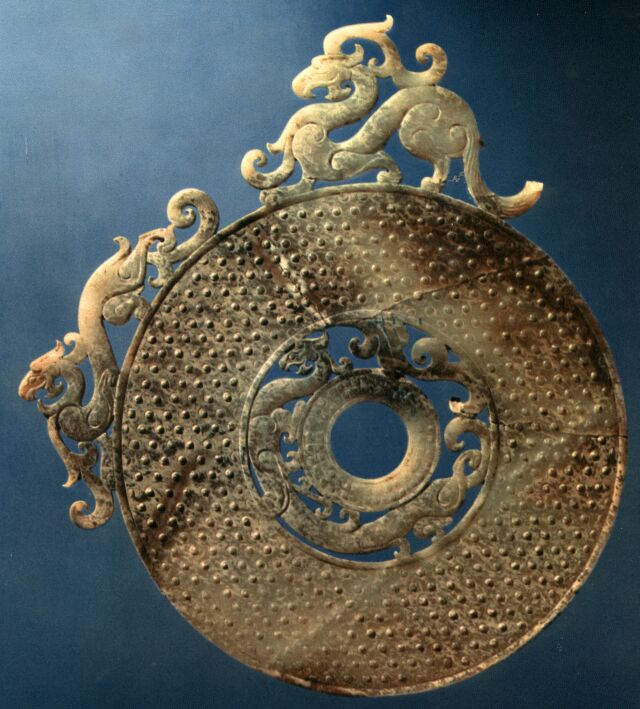
[8-color GIF] (Image © New Image.)
[279K]
We now embark on a new voyage on the seas of time. The model for our vessel is the Jade Pi Disc illustrated in the National Geographic Magazine article "Jade, the Stone of Heaven," on page 285 of the September 1987 issue. This ancient art form uses elements of a modified framework of mathematics to encode its message. Traditionally the Pi Disc is regarded simply as a ceremonial object used for the worship of the heavens. As an Art form, it not only regards the heavens but is the carrier of a metrological tradition as well. See illustration following page.
| RING | DIAMETER inches | AREA sq.inches |
| h | 6.514294315 | 33.33335722 |
| g | 6.3654 | 31.827 |
| f | 3.298963744 | 8.54686478 |
| e | 3.070171385 | 7.404053422 |
| d | 1.8659116 | 2.73405431 |
| c | 1.681792831 | 2.221719865 |
| b | 1.128308469 | 1.0 |
| a | .954810684 | .716108525 |
| TOTALS: | 24.87965342 | 87.83315812 |
Observation One
There are 8 concentric circles underlying the ornamentation of the Jade Disc.
Starting with the largest, the dimensions in inches are as follows: See DIAGRAM A.
Process:Sum the length of all eight diameters. The total length is 24.87965342 inches.
Construct one circle with 24.87965342 inches as a diameter. See DIAGRAM B.
The circumference of this circle will be 78.17153176 inches2 or 6.514294313 feet.
Note: The circumference of the derived circle B has the same number but in feet as the number of inches in the diameter of the largest diameter h of the Disc: 6.51429315. The derived form B, like a catalyst, actualizes a potential previously not available to A.
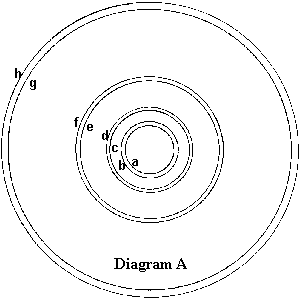
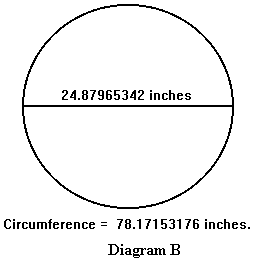
Observation Two
Since there are eight different circles in the Jade disc, divide
the derived circumference of B by 8:
78.17153176
----------- = 9.771441472
8
Note: The number 9.771441472 will be referenced often in Monumental Art. One of the significant attributes of this number is that it is identical to the length of a pendulum which will beat one second of time (one full swing forth and back), exactly 9.771441472 inches.
Now find the square of 9.771441472 and divide by 100:
9.7714414722
------------ = .954810641
100
Note redundancy: The innermost diameter a of the Pi Disc is also .954810641 inch.
See that: One eighth of the derived circumference of B (9.771441472) is exactly 1.5 times the diameter of the actual Jade disc (6.514294315).
78.17153176 9.771441472
----------- = 9.771441472 then: ----------- = 6.514294315
8 1.5
Most importantly notice that: The number 8 divided by the diameter of the actual disc is:
8
----------- = 1.228068554.
6.514294315
This last number, 1.228068554 is pivotal in the translation of time to length. It recurs frequently in the Monument System, and will be referenced several times as we unwind the labyrinth of the disc. When it is taken as the exact number of feet in the length of a pendulum, that pendulum would beat a period of time in seconds identical to its length: 1.228068554 seconds. 1.228068554 feet.
Observation Three
The diameter of the second innermost b circle is
1.128308469 inches.
Note: The area of that circle is exactly one square inch.
See that: 1.12830846922 = 1.27308.
1.27308 × 45° = 57.2886 The Canon Radian of the Circle
Observation Four
The number 8 plays a significant role in the design of
this piece.
Note: The square root of the number 8 is 2.828427125. Holding that figure in mind, notice that if the circumference of our derived circle B (78.17153178 inches) is used as the length of a pendulum, the period of this pendulum will beat 2.828427125 seconds of time, the same number as the square root of 8.
The third diameter c 1.681792831 inches, is the fourth root of the number 8.
Observation Five
The number of square inches occupied in the area of ring K
(see diagram) is similar to a number modernly given as the
rate of period doubling to chaos, or "Fiegenbaum's Number":
4.669246833. This number has its own anti-common log
multiplied by 10,000:
4.66924683310 = 46692.46833.
(In his writings, Fiegenbaum apparently did not notice this synchronicity. Actually the Fiegenbaum value is given as 4.6692016. Fiegenbaum's Number departs from the Canon figure by a little over one hundred thousandth.)
Observation Six
The pendulum, as an instrument just does, it is pure physics.
When coupled with the heartbeat however, we initiate the fundamentals of
measure based on physiology.
The commensurability factor of units of length which translate into units of time via the pendulum enables metrological transformation. One number can indicate another. One number may be imbedded within another. But a mathematical (and sometimes magical) function must be utilized to liberate the unseen value. he function could be a square root, a logarithm, or the reciprocal of a number. The participant/observer must invoke an intuitive leap in order to access the hidden. Through the lens of intuition, the new relationship emerges.
For instance, out of the emptiness of the inner circle of the Jade disc, we will derive the ultimate Time/Length factor. In the beginning, the path seems circuitous, but then the familiar is revealed.
The Process: The area of the inner (empty) circle a is .716108525 of an inch.
Although not obvious at first, further exploration will reveal that this number, times 10 is an "indicator" of the pendulum whose period has the same number of seconds as its length has in inches.
.716108525 × 10 = 7.16108525
The square root of 7.16108525 is 2.676020414
The reciprocal of this,
1
----------- = .3373689227
2.676020414
Use this number to multiply the value of the Cannon Meter, in inches, as
.3373689227 × 39.4362 = 14.73688309 inches
Dividing 14.73688309 inches by 12 to derive feet we arrive at:
14.73688309
----------- = 1.228073591 feet
12
This is almost 1.228068554 the number of feet in the length of a pendulum that beats the same number of seconds as the measure of its length in inches.
A further redundancy is indicated when it is seen that:
The square inches in the empty center: .7161084613
Taken to its anti-natural logarithm = 2.04645384 and multiplied by 10
is almost the same number of inches as in the circumference of the real jade disc:
20.4678239
20.4678239
----------- = 3.14148201. This last a very close value of pi.
6.513248639
The idea can be rendered but only as a sensible copy of the ideal.
A moment of openess initiates transformation. The artist captures the
moment as an image. The image is reduced to an idea. The idea
can then be expressed as language, geometry, number, shapes, sculptures
etc. The last aspect of the artist's act is submission to the limitation
of his medium: his idea can be conceived; but the object can
only be rendered as an approximation of the idea. The is no guarantee
that a person who has experienced the sacred, is going to precipitate a
sacred work in the world. The best that the artist can hope for is that
someone else may appreciate his intention, and see through the form to
the idea in the mind of its originator, to the level of the perennial.
Appendix: Canon and Convention
Canon Measures are observably a departure from modern
conventional units. Bear in mind that the purpose of modern measures is
primarily functional. Conventional measures are traditional and for the
most part arbitrary. They are none the less, useful for keeping
schedules, navigating, and negotiating commerce. The authority of the
convention rests in the agreement of those who adhere to it.
Conversely, the Essential Canon of Measure is initiated by universals—ideal units of frequenecy assigned after millennia of observation. Canon units are characterized by internal commensurabilities and strange mathematical relationships. Although the intuitive levels are not unfamiliar to poet and mystic, many of these relationships defy the limitations of our logic, yet they occur. The opportunity exists for the scientist to explore the realm and from another frame of reference, discover new questions.
The origin, evolution and rationale of the following short list of Canon measures are detailed in another work.
TABLE I: Metrological Aspects of the Canon Based on a Magnetic Framework3
TABLE II: Conventional Mathematical Processes Used
15° × sin l = precession in degrees per hour on a latitude l.
T = 2 ![]()
![]() l / g
l / g
Table III: The Conventional Geographic Framework
1.) 1.618033989, the Fibonacci Number closely resembles the Canon
number. But in the quest for mathematical perfection sacrifices it
relationship to nature: The reciprocal of the Fibonacci Number is itself
minus 1:
1
----------- = .618033989
1.618033989
On this tiny point the link between mathematics, natural form and the
Canon was lost.
2.) 78.17153176 inches is also 1.982227795 Canon meters. This number
taken as minutes and squared (3.92922703) represents a reasonable
decimal value for the difference in minutes between the Mean Solar Day
and the Mean Sideral Day, 03 min 55 sec .7536.
3.) The time systematics in the Canon register Earth rotation in terms
of the Eart h's magnetic geometry. The Canon paradigm departs from
contemporary time systematics on this point. Fo r example, one day of
Earth rotation in the Canon System becomes 87,636 seconds of time, as
compared t o the conventional figure of 86,400 seconds. The ratio
between the two systems is:
87,636
------ = 1.01430555
86,400
4.) Conventional conceptualizations about "gravity" are locked to
relativistic considerations and constraints Newton denied in personal
writings any knowlege of or ascent to the notion of "a ttraction." There
is at present probably not a single physics textbook which attends to
this error in re porting. Newton himself may have been an unwitting
participant in sustaining the delusion of attraction in the Principia
while denying it personally in private communications to others. See
Newton: The Third Book of Optics.
5.) There can be no true Canon value for the 1st second of fall, since
the object is already in motion in the cosmodesic acceleration.
6.) Based on the adopted Clarke Spheroid of 24,901.55 miles Equatorial
circumference, wherein the mile @ 5280 feet is not required to be
commensurate with a time systematics.